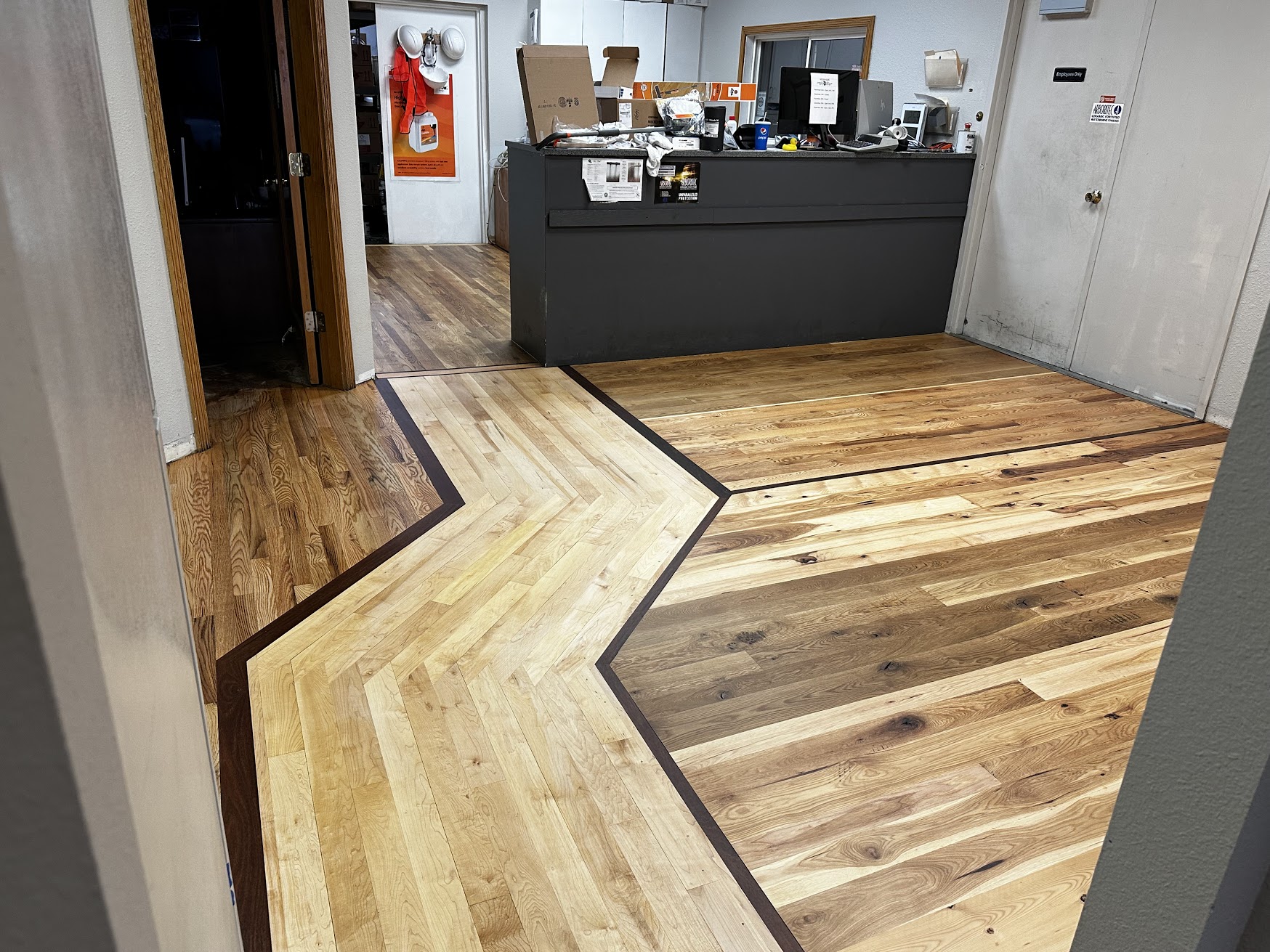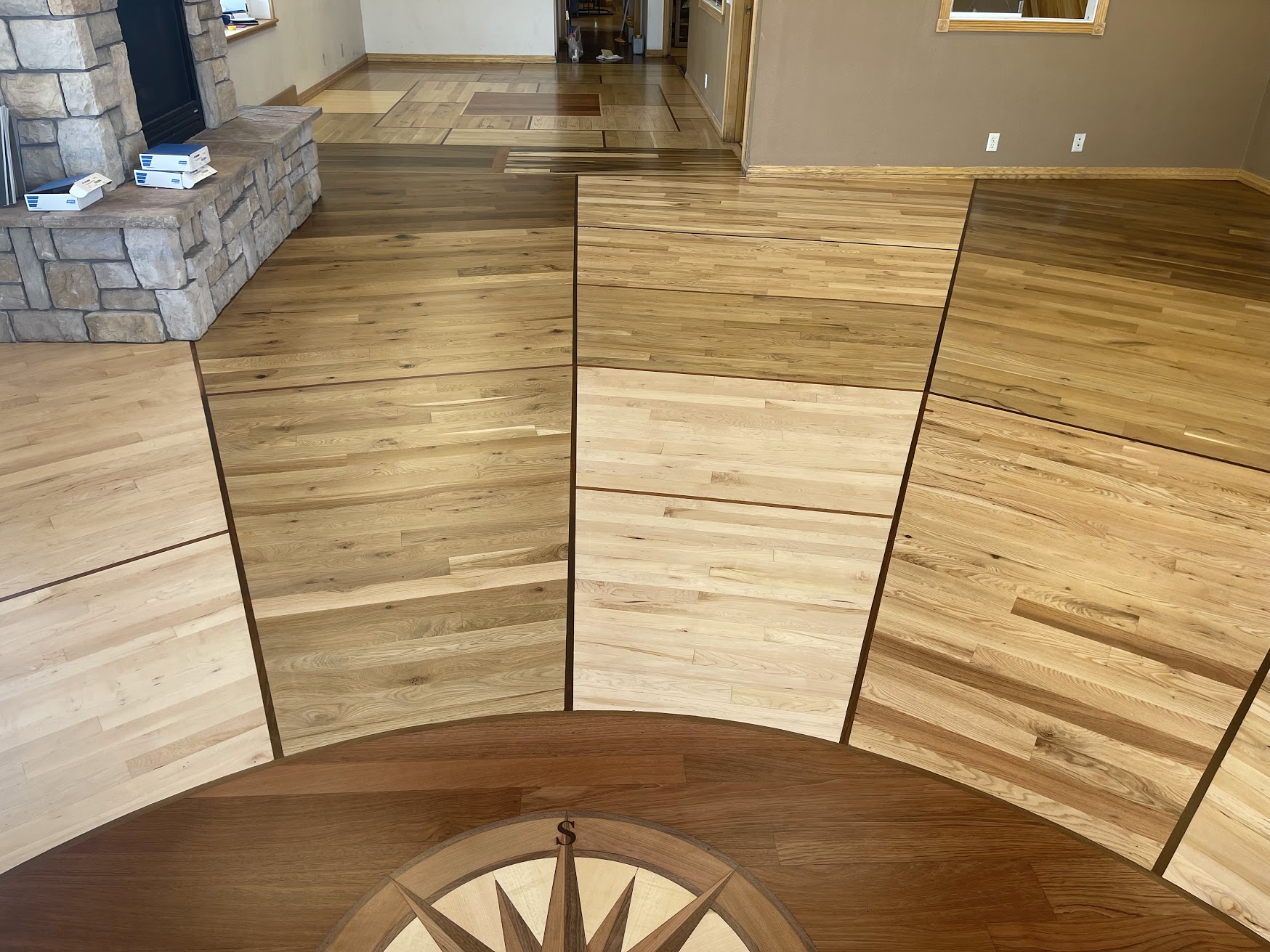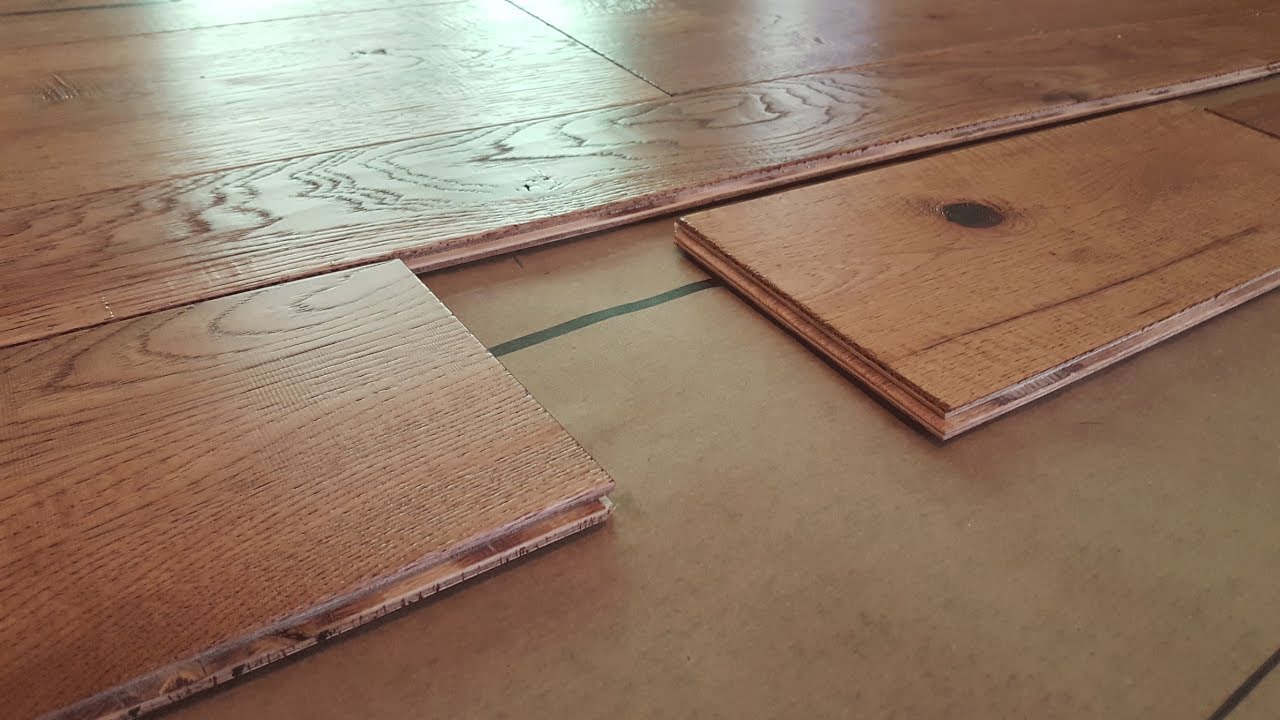Before you dive in, here’s a quick snapshot of the 7 popular flooring trends of 2025:
- Eco‑Chic Materials: Engineered hardwood, reclaimed wood, bamboo, cork and large‑format stone/tiles combine beauty with smaller carbon footprints.
- Biophilic Vibes: Warm earth‑tone hues (honey, terracotta, rich browns) and organic textures (hand‑scraped, brushed grain) bring nature indoors.
- Wood Reinvented: Extra‑wide planks, warm wood tones and geometric patterns (herringbone, parquet) turn floors into statement pieces.
- Next‑Gen Vinyl & Laminate: Waterproof Luxury Vinyl Tile (LVT) and laminate now look ultra‑realistic and withstand spills, dents, and temperature swings.
- Bold Patterns & Sizes: Preconfigured herringbone/chevron kits, massive 24×48″ tiles, and vibrant mosaic designs create eye‑catching focal points.
- Warm, Versatile Palettes: Soft beiges, taupes and greiges dominate, with jewel‑tone accents and vibrant area rugs adding drama.
- Carpet’s Comeback: Geometric prints, layered textures (frieze, high‑low piles) and digital‑print customization make carpet a design hero once again.
Keep these key points in mind as you explore each trend in detail below.
Flooring choices have undergone remarkable changes in 2025. The market now responds to homeowners who demand floors that deliver beyond aesthetics. Durability ranks high on priority lists, alongside ease of maintenance, environmental impact, and overall value for money.
Several materials have gained significant popularity this year. The industry has witnessed a strong push toward sustainability, with manufacturers now offering eco-friendly alternatives without sacrificing quality or beauty.
Remote work arrangements continue to influence what people want underfoot. Floors must now withstand all-day traffic while providing comfort during extended home use.
1. Sustainable Natural Materials Lead the Way Forward
More homeowners now prioritize materials with smaller carbon footprints without sacrificing style and beauty. This trend reflects broader consumer awareness about environmental impact.
Hardwood Flooring
Engineered hardwood has become the go-to sustainable choice for many renovations. These products deliver excellent stability while conserving precious hardwood resources. FSC-certified sources now represent the standard for quality manufacturers.
Reclaimed wood floors offer incredible character with genuine environmental benefits. Salvaged from old structures, these materials showcase authentic weathering and unique markings. The distinctive aged appearance gives spaces depth and story, impossible to replicate in new products.
Stone and Large Format Tiles
Natural stone remains a premier flooring option this year. Materials like marble, limestone, and travertine bring organic elements indoors with unbeatable longevity when cared for properly.
Large-format tiles have taken over modern spaces. These bigger tiles create fewer grout lines, making rooms look larger and cleaning much easier for busy households.
Bamboo Flooring
Bamboo stands out as an environmental superstar among flooring materials. Growing to maturity within 5 years versus decades for hardwoods, bamboo delivers true sustainability.
Manufacturing improvements have addressed previous durability concerns. The strand-woven variety now outperforms many traditional hardwoods in hardness tests, handling high-traffic areas with ease.
Cork Flooring
Cork offers a unique combination of comfort and environmental benefits. Harvested without harming trees, this material represents genuinely sustainable forestry practices.
Cork floors provide several practical advantages:
- Better temperature regulation
- Reduced noise transfer between floors
- Natural cushioning for standing comfort
Recent advances have boosted cork’s water resistance, making these floors suitable for more rooms throughout the home.
2. Biophilic Design Elements Dominate Modern Interiors
People want their indoor spaces to feel connected with nature, creating rooms that bring a sense of calm.
Nature-Inspired Color Palettes
Cool grays have fallen out of favor as warm earth tones take over the flooring market. Honey, terracotta, and rich browns now dominate across all materials.
This swing toward warmer colors connects to our growing focus on comfort and wellbeing at home. These natural shades help spaces feel more nurturing and grounded.
Textured Surfaces
Texture matters just as much as color now. Hand-scraped wood with subtle depth variations sells exceptionally well. Brushed finishes that bring out natural grain patterns add another layer of visual interest while keeping that crucial connection to organic elements.
3. Wood Flooring Options Continue Strong Market Presence
Wide Plank Flooring
Homeowners now gravitate toward wider planks almost exclusively. Boards 7 inches or wider dominate new installations, showing off gorgeous grain patterns with fewer seam interruptions. Rooms instantly look bigger and more cohesive with these broader planks.
Warm Wood Tones
Gray and whitewashed woods have fallen dramatically out of fashion. Rich, warm tones like honey, caramel, and amber now rule the wood floor market. These colors bring genuine warmth and character to any room.
Oak floors still lead in popularity thanks to their remarkable durability and distinctive grain. For darker spaces, walnut has become the top premium choice among discerning customers.
Geometric Patterns
Boring straight layouts? Not in 2025. Parquet and geometric wood patterns have roared back into style. Herringbone layouts top current design choices, blending timeless appeal with fresh execution. These patterns elevate floors from simple surfaces to standout design features.
4. Luxury Vinyl Products Reach New Heights
Gone are the days of obvious fake-looking vinyl. The latest technology delivers products that look amazing while handling real-life challenges.
Luxury Vinyl Tile Dominates Practical Spaces
LVT sales continue climbing as visual quality keeps improving. Deeper embossing and sharper imaging make these products nearly indistinguishable from the natural materials they mimic.
Homeowners love the waterproof benefits in bathrooms and kitchens. Many have started running the same LVT throughout their main floor for a cohesive look without worrying about spills or pet accidents.
The core construction works better than ever, too. SPC and WPC cores resist dents and temperature changes, fixing problems that plagued earlier vinyl products.
Waterproof Laminate Makes Gains
Waterproof laminate has finally solved the biggest problem with traditional laminate floors. You can now get affordable laminate that actually stands up to moisture.
The best products offer genuine 24-hour water protection. This game-changing feature opens up kitchen and bathroom installations that were previously off-limits.
Better edge sealing and water-resistant cores mean everyday spills no longer spell disaster. The wear layers have improved too, fighting off scratches and sun damage much better than older products.
Engineered Hardwood Evolves
Engineered hardwood keeps getting better with improved stability in changing humidity. Many options now feature wear layers thick enough for future refinishing, just like solid hardwood.
The price hits a sweet spot between luxury vinyl and solid wood, perfect for homeowners who want real wood without breaking the bank. Face options have exploded in variety, bringing exotic wood looks within reach through smart engineering.
Installation has gotten much simpler with click-lock systems, many homeowners can handle it themselves. This DIY-friendly approach has made authentic wood floors accessible to more budget-conscious customers.
5. Bold Design Choices
Herringbone and Chevron Patterns Everywhere
Geometric patterns work with virtually any flooring material now. Herringbone layouts remain the top choice, with chevron designs close behind.
These patterns instantly upgrade ordinary materials into something special. Most people choose to feature them in entryways, dining areas, or main bathrooms, where guests notice the extra detail.
Floor manufacturers have noticed this trend and now offer products specifically designed for pattern installation. What once required expert installers has become much more accessible thanks to pre-configured systems that anyone can work with.
Large Format Tiles Transform Spaces
Tiny tiles? Not anymore. Standard 12×12 inch squares look outdated as huge 24×48 inch tiles take over modern installations.
These massive tiles create spaces with minimal grout lines and maximum visual impact. They work particularly well in open floor plans where they help unify kitchen, dining, and living areas into cohesive spaces.
Technical improvements have solved previous installation headaches. Rectified edges allow perfect alignment, while new setting materials prevent lippage between tiles.
Creative Tile Designs
Wood look tiles keep growing in popularity, especially for wet areas where real wood would suffer. Today’s wood-look tiles feature amazingly realistic grain patterns and surface texture while providing superior moisture protection.
6. Warm Color Palettes Dominate Flooring Choices
Floor color trends have done a complete 180 this year. Cold, stark options have fallen out of favor as homeowners gravitate toward warmer, more inviting tones across all flooring types.
Warm Neutrals Lead Market Trends
Beige floors have mounted a serious comeback in 2025. Modern beige looks nothing like the flat, boring beige from decades past. Today’s versions feature rich undertones and subtle variations that add real character to any room.
Taupe shades work beautifully as middle-ground options between traditional beige and gray. These adaptable colors play well with almost any design style, making them smart choices for homeowners who like to update their décor frequently.
Soft browns with hints of gold or red undertones have taken over the market. These warming colors create spaces that feel genuinely welcoming rather than cold or clinical.
Bold Color Statements
While neutrals rule the overall market, bold colors shine in smaller spaces. Jewel tones like emerald, sapphire, and ruby make stunning statements in powder rooms or entryways where people can appreciate dramatic flair.
Vibrant patterned tiles create perfect focal points in otherwise neutral rooms. Many homeowners now choose colorful tile mosaics while keeping most flooring more subdued for balance.
Rich, colorful carpets have found their way back into bedrooms and living areas. Deep, saturated colors add sophisticated drama to spaces where comfort matters most.
Gray Still Has Staying Power
Gray hasn’t disappeared entirely despite the warm color revolution. Greige options that blend gray and beige elements remain incredibly popular as transitional choices.
Warm grays with hints of taupe or brown create bridges between contemporary design and cozy comfort. These versatile colors excel in homes that mix modern and traditional elements.
Most designers now steer clients away from pure cool grays. These can feel unwelcoming compared to the warmer alternatives currently dominating flooring showrooms.
7. Carpet Makes Stylish Comeback in Key Areas
No longer the boring beige background material, modern carpet styles now make bold design statements throughout many homes.
Bold Patterns Create Visual Interest
Geometric carpet designs have exploded in popularity this year. Angular patterns, bold stripes, and abstract motifs turn ordinary floors into conversation pieces that demand attention.
Floral patterns have evolved dramatically from your grandmother’s carpet. Modern versions feature oversized blooms or abstract botanical elements that perfectly complement the natural elements trend running through current home décor.
Custom carpet designs have finally become affordable through new digital printing technology. Homeowners can now specify exactly what they want without paying the astronomical prices previously associated with custom floor coverings.
Layered Textures Add Dimension
Multi-level pile carpets offer both visual and tactile appeal through varying heights. Cut and loop construction creates subtle patterns using texture rather than relying on color contrasts alone.
Frieze carpets with their tightly twisted fibers have surged back into popularity. The relaxed, casual look works perfectly in family spaces while hiding traffic patterns and vacuum marks much better than traditional cut pile.
High-low textures combine different pile heights to create subtle interest. These variations add sophistication without introducing bold colors that might quickly feel dated.
Vibrant Colors Make Statements
Deep, rich colors dominate carpet trends in 2025. Emerald green, sapphire blue, and ruby red carpets create dramatic rooms that feel luxurious and intentional.
Colorful area rugs serve as anchor points in rooms with hard surface flooring. Designers frequently layer vibrant rugs over neutral wood or vinyl floors to add warmth and personality.
Final Thoughts
Homeowners benefit from unprecedented choice when selecting floors for their spaces. The emphasis on sustainability continues to drive product development, with eco-friendly options available across all price points and categories.
Whether renovating a single room or building a new home, understanding these trends helps create spaces that feel both current and timeless. The best flooring choices balance trendy elements with lasting appeal for investments that maintain value for years.
Rustic Wood Floor Supply crafts premium sustainable hardwood flooring with distinctive grain patterns that elevate any room. Our collection features both engineered and solid wood options with customizable finishes to match any design vision.
FAQs
How long do engineered hardwood floors typically last?
Quality engineered hardwood floors can last 20-30 years with proper maintenance. Premium options with thicker wear layers (3mm+) can be refinished multiple times, extending their lifespan to rival solid hardwood.
Are luxury vinyl tiles suitable for radiant heating systems?
Most luxury vinyl tiles work well with radiant heating systems. Look for products specifically rated for this application with maximum temperature ratings. SPC core vinyl typically conducts heat more efficiently than WPC core options.
What are the cost differences between solid and engineered hardwood?
Engineered hardwood typically costs 10-15% less than comparable solid hardwood. Premium engineered options with thick wear layers may approach solid wood pricing, while offering better stability in changing humidity conditions.




